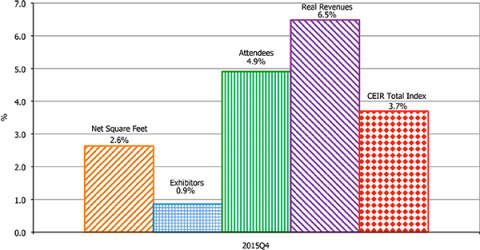Trade Show Industry Sees 3.7 Percent Q4 and Full-year Uptick for 2015

The Center for Exhibition Industry Research’s CEIR Total Index, which tracks the overall health of the trade show industry, ended last year with a substantial uptick in not only the fourth quarter, but also for the full year.
The index posted a strong year-on-year gain of 3.7 percent in the fourth quarter. This growth is the second highest rate since the second quarter of 2012. It also marked the 22nd consecutive quarter of year-on-year growth.
During the three years, 2012 through 2014, the exhibition industry growth generally lagged the pace of GDP, but the industry has now outperformed the macro economy for four quarters straight, and by a wide margin, according to CEIR.
“The strong momentum in the exhibition industry could carry forward into 2016 and offset weaker macro factors,” said CEIR Economist Allen Shaw, Ph.D., chief economist for Global Economic Consulting Associates.
All four exhibition metrics in the fourth quarter posted year-on-year gains. As was the case during the first three quarters of 2015, the strongest metric was Real Revenues (nominal revenues adjusted for inflation) – which rose an impressive 6.5 percent – followed by Attendees, increasing by 4.9 percent. Net Square Feet increased 2.6 percent and Exhibitors rose 0.9 percent.
In line with expectations as presented at last year’s CEIR Predict Conference, the Total Index increased by a robust 3.7 percent for 2015 for the year as a whole, 1.8 percentage points higher than in 2014.
Real Revenues had strongest growth among the four metrics, gaining 6.2 percent from 2014. Attendees continued its upward trend since the end of the recession in 2009.
In 2015, attendees exceeded its previous peak in 2007, 33.4 million and 32.4 million, respectively. To a large extent, the gains in Attendees during the last few years has been propelled by a strengthening job market.
Since Attendees is a leading indicator of the exhibition industry, good news on attendance bodes well for business in coming years.
The overall exhibition industry’s performance varied by sector. The best performing sectors were (1) Industrial/Heavy Machinery and Finished Business Inputs (ID) and (2) Building, Construction, Home and Repair (HM), which gained 12.9 percent and 10.1 percent, respectively.
Both sectors benefited from rebounds in housing construction and robust auto sales. On the other end of the spectrum, the weakest sector was the Government sector, where the index declined by 1.3 percent. This isn’t a surprise as governments at all levels and functions continued to face tight budgets, especially for training, education and travel.
“We anticipated 2015 would deliver positive results and yet we were pleasantly surprised that the industry outperformed our original projections,” said CEIR President and CEO Brian Casey, CEM.
He added, “While there are varying perspectives on the future performance of the U.S. economy, we remain optimistic for the year ahead. Stay tuned for our full 2015 Index report scheduled for delivery on or around April 1st.”
Click here for information on how to purchase the complete CEIR Index Report, which analyzes the 2014 exhibition industry and provides a future outlook for the next three years.
Predict: CEIR’s Annual Outlook Conference will be held Sept. 14-15 at the Ronald Reagan Building and International Trade Center in Washington, D.C.
The event provides an outlook on the global economy and the exhibition industry’s performance. Visit www.ceir.org/predict for more details.


Add new comment